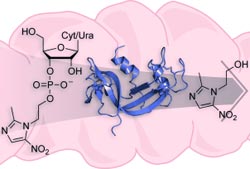Timely Delivery

<br>
Many drug candidates fail because of low solubility or poor pharmacokinetic behavior. Ron Raines and colleagues at the University of Wisconsin–Madison (USA) have devised a new prodrug strategy to overcome these limitations.
Their approach takes advantage of the capacity of an enzyme prevalent in human serum–pancreatic-type ribonuclease—to catalyze the cleavage of a drug conjugated to a ribonucleoside 3'-phosphate; the results of their work are reported in ChemMedChem.
They demonstrated efficacy by using metronidazole, a sparingly soluble antibiotic that is often administered orally. In the absence of ribonuclease, metronidazole conjugates are stable and inactive. Physiological levels of enzyme render the conjugate toxic to Bacteroides fragilis, a common penicillin-resistant bacillus that is responsible for anaerobic infections.
Alterations to the ribonucleoside enable modulation of key attributes, such as the rate of drug delivery. This study paves the way for further research into the activation and timed release of drugs of varying aqueous solubility.
About the Author
Dr. Ronald T. Raines is the Henry Lardy Professor of Biochemistry and a Professor of Chemistry at the University of Wisconsin–Madison. His research is focused on the chemistry and biology of proteins.
Author: Ronald T. Raines, University of Wisconsin–Madison (USA), http://www.chem.wisc.edu/users/raines
Title: Ribonucleoside 3'-Phosphates as Pro-Moieties for an Orally Administered Drug
ChemMedChem 2012, 7, No. 8, Permalink to the article: http://dx.doi.org/10.1002/cmdc.201200243
Media Contact
All latest news from the category: Life Sciences and Chemistry
Articles and reports from the Life Sciences and chemistry area deal with applied and basic research into modern biology, chemistry and human medicine.
Valuable information can be found on a range of life sciences fields including bacteriology, biochemistry, bionics, bioinformatics, biophysics, biotechnology, genetics, geobotany, human biology, marine biology, microbiology, molecular biology, cellular biology, zoology, bioinorganic chemistry, microchemistry and environmental chemistry.
Newest articles

“Nanostitches” enable lighter and tougher composite materials
In research that may lead to next-generation airplanes and spacecraft, MIT engineers used carbon nanotubes to prevent cracking in multilayered composites. To save on fuel and reduce aircraft emissions, engineers…

Trash to treasure
Researchers turn metal waste into catalyst for hydrogen. Scientists have found a way to transform metal waste into a highly efficient catalyst to make hydrogen from water, a discovery that…

Real-time detection of infectious disease viruses
… by searching for molecular fingerprinting. A research team consisting of Professor Kyoung-Duck Park and Taeyoung Moon and Huitae Joo, PhD candidates, from the Department of Physics at Pohang University…





















